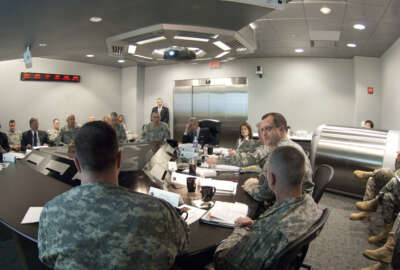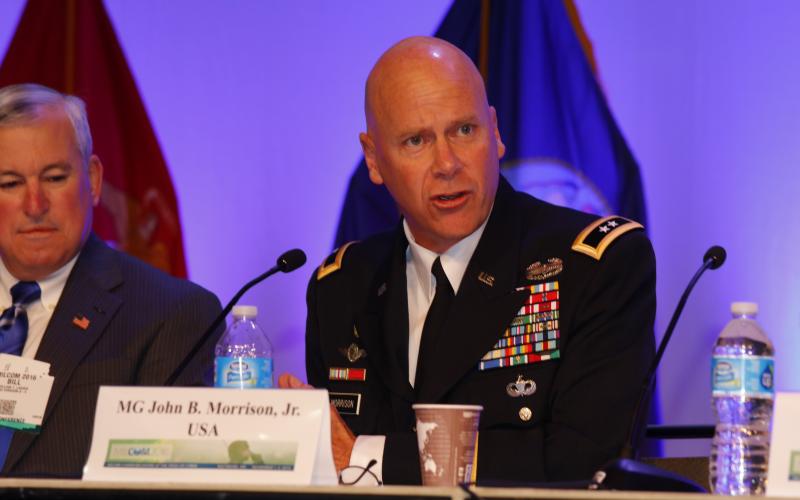

Lt. Gen. John Morrison Jr., the deputy chief of staff, G-6, said his office reached initial operating capability in the first two months since the secretary split...
It’s been about two months since the Army split its technology management organization into two, creating a new office of the chief information officer and an office for the G6.
While the role of the CIO’s office faced little change, the newly formed G6, which answers to both the CIO and the Army chief of staff, has to find its sweet spot among the technology offices across the service.
Lt. Gen. John Morrison Jr., the deputy chief of staff, G-6, said Tuesday as part of this new organization reaching initial operating capability, its roles and goals are coming into focus.

“The CIO is the principle advisor to the Secretary of the Army. They really focused on policy, governance and oversight. It’s all things IT related,” Morrison said during a conference call with reporters on Tuesday. “On the G6, it’s a little bit of a different focus. It’s really about strategy, network architectures and implementation of command control, communications, cyber operations and networks. The CIO establishes the policies. We are responsible for planning and actual implementation of those policies, and then supporting Army organizations worldwide as they actually go out and implement those policies.”
He said the power of having two aligned organizations that are focused on driving vertical and horizontal integration and on cyber and IT challenges from both the secretary’s level and from the chief of staff’s perspective.
Morrison said he expects the G6 to reach full operating capability in fiscal 2021.
The Army became the third service in the last three years to reorganize its CIO office. In 2018, both the Air Force and the Navy restructured their respective CIO offices. The Navy got rid of the Department of Navy CIO office and gave the title to the undersecretary of the Navy. The Air Force followed a similar path a few months later adding the formal title to the undersecretary.
Sources tell Federal News Network, however, that the Air Force may be moving back to the pre-2018 configuration where the undersecretary no longer holds the title of CIO.
Morrison said the Army is using the lessons learned from the Navy and Air Force as the two new offices gain their respective footholds.
“You’ve seen some things that are different. The mere fact that cyber operations are included in the G6 is not traditional. But it gets back to the notion of if you believe in combined arms maneuver in cyberspace to include electromagnetic spectrum, why would we separate that role and function?” he said. “There is work for us to do there. But I’d also submit to you that’s one of the lessons learned from the other services because that’s generally how they organized.”
Morrison said the G6 will focus its efforts across four pillars of effort.
Morrison said it’s integrating the work of the cross-functional team with the tactical network and also focused on the notion of vertical integration.
“If you buy into many of the things that we are working on from our modernization priorities or our operational framework—long range precision fire, deep persistent intelligence, surveillance and reconnaissance (ISR), and multi-domain operations where cyber effects at the tactical level could be deployed just about anywhere on the globe—you need a unified network,” he said. “We have to stop talking about an enterprise network that is focused on modernizing our base, post, camp and installations and a tactical network that is very base, post and camp centric. We need to bring those two together so that we support where the Army is going from both a modernization and an operational warfighting construct.”
This network also will be the Army’s contribution to the Joint All-Domain Command and Control (JADC2) to ensure networks are interoperable and can share data.
Morrison also said the unified network must take into account new and emerging technologies like 5G and secure wireless.
“We have to be able to break down the individual theater architectures and make it easy for formations that are actually in CONUS to rapidly deploy to any area of operations and immediately plug in and start conducting operations,” he said. “That needs to be our goal. How do we set that environment to enable those kinds of operations?”
He said cyber and electronic warfare are linked and can’t be separated if they are part of multi-domain operations.
“That means taking a look at the training. That means taking a look at the talent management. That means taking a look at the organizational framework that we are putting in place and as we learn, adjusting them over time,” he said. “That means making sure we have signal and cyber underpinned by intelligence, operating in a combined arms fashion in cyber space to include electromagnetic spectrum.”
He said the effort must support the unified network and building additional cyber capacity to operate at the tactical echelons.
Morrison said he wants to review the risk management framework and see how the Army can move from a model that is less focused on bureaucracy and periodic reviews to one that is more focused on operational evaluations to ensure cybersecurity is a part of a system before it gets on the network.
“It’s a different process on focusing the RMF process on pre-connections and moving legacy processes that came out of old information assurance procedures to more of an operational focus,” he said.
He said the goal is to develop capabilities the Army needs with the right linkages back to the joint environment.
“How do we harmonize joint investments in the joint tactical grid which supports the unified network, and how do we make sure we are leveraging all the investments so that we are effective as a joint force, as an Army, and fiscally efficient?” he said.
The biggest challenge the G6 faces is hiring and training employees to have the right skillsets.
Like most public and private sector organizations, the G6 is in need of employees who understand cloud services, data analytics and cybersecurity.
Morrison said he has asked his staff to look at using all current hiring authorities to address these and other needs.
“We have gotten approval to take a look at some of our vacant positions and really take a look at the position descriptions and then rewrite them for the skillsets we need on both the CIO and G6 side,” he said. “This is one of those rare opportunities where you are able to set two organizations to really posture themselves and the Army for the future. It’s not about just getting the authorizations to do it, but actually hiring the folks on.”
Copyright © 2025 Federal News Network. All rights reserved. This website is not intended for users located within the European Economic Area.
Jason Miller is executive editor of Federal News Network and directs news coverage on the people, policy and programs of the federal government.
Follow @jmillerWFED


